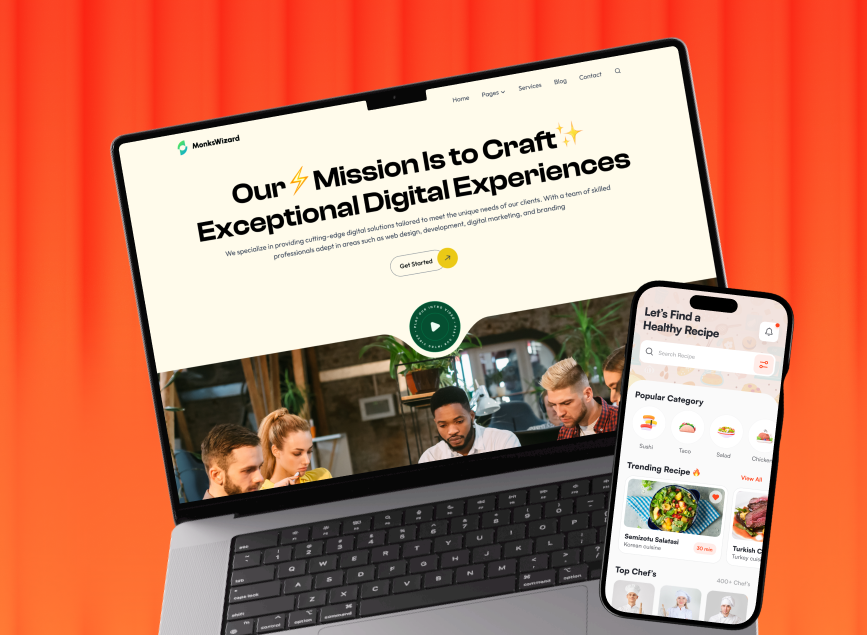
Key Takeaways
- User research uncovers real needs, behaviors, and pain points effectively.
- Clear objectives and hypotheses guide research and keep efforts focused.
- Choosing the right method ensures relevant and actionable insights.
- Analyzing and synthesizing data transforms observations into informed design decisions.
- Proper research reduces risk, improves usability, and boosts user satisfaction.
User research is the cornerstone of successful UX design. It’s the best possible way to get essential insights into the needs, behaviors, and preferences of users. However, most beginners make mistakes in conducting user research in the right way.
Here, you must be confused about exactly how to conduct a UX research process, right? The truth is, that you need to follow proper step-by-step guidance that starts with finding the research objective and leads you to the way to get the expected findings.
I won’t disagree that making a proper UX research plan is very easy. Unless you are on the right track, finding yourself in an uphill battle is more common than finding the Big Apple. However, don’t worry. Keep reading and you’ll learn what to do and how to do with all your answers in one place.
What is User Research?
User research in UX design is like being a detective, but instead of solving crimes, you have to figure out how to make websites and apps super user-friendly.
Here, you need to talk with people, observe how they use stuff, and ask lots of questions. Think of it as a way to get inside the heads of the folks who'll actually be using what you'll design.
Well, let me be a little more frank. Suppose, you're making a new cooking app. UX research helps you understand if people prefer step-by-step recipes or preparation videos if they want to save recipes for later, or if they need help with grocery lists.
By talking to users, watching them cook, and observing their behavior, you can gather all the clues you need to whip up an app that everyone loves to use.

According to The Forage,
“Building a truly useful, meaningful product needs researchers and teams to empathize and understand their users’/customers’ needs.”
Zohrane Dyer, senior user experience consultant at UX Connections
Ultimately, it's about placing users at the heart of the design process, so the end result is not just functional, but a joy to use. Also, the success of your product design pretty much depends on how well you have conducted this stage.
Conducting User Research in Easy 7 Steps
To make sure of a thorough and effective process, it's always recommended to conduct user research in several steps. These steps are categories based on specific purposes and they contribute to the overall success of the research endeavor.
Here, we have added a step-by-step approach that helps maintain a systematic and organized research process.
Step 1: Define Objectives
The first step is to define clear objectives for your research. Here the objectives are the goals you want to achieve through your research. These goals will guide the entire process and help you stay focused on what's important.
While defining your objective, you need to ask yourself a few research questions:
- Why are you conducting User research?
- Are you trying to improve an existing product, develop a new product, or understand user behavior in a particular context?
- What specific outcomes do you hope to achieve through the research?
- Who are the users you're interested in studying?
Generally, objectives help you narrow down the scope of your research and focus on specific aspects of user behavior or experience. Also, it ensures that your research efforts are purposeful and targeted.
At the same time, a properly defined set of objectives can help you avoid wasting time and resources on gathering irrelevant information. For sure, clear objectives provide a benchmark against which you can measure the success of your research.
Step 2: Raise Your Hypothesis
In this step, you're like a detective making educated guesses about what you might find during your investigation. These guesses are called hypotheses.
In the process of conducting user research, it's common for designers and teams to already have ideas and assumptions about what they are going to work on. Especially after setting their objective, they automatically come to an early hypothesis.
As a designer, you should be confident in this part. You should consider your hypothesis as predictions or hunches based on what you already know or suspect.
However, you should never start designing just focusing on these hypotheses. Remember, your assumption can be different from what the end user will expect from the product.
However, your hypothesis can give you something to test during your research. Now, it's your task to check the validity and expected outcome of the hypothesis you have made. This is where your main research work will start.
If your research confirms your hypothesis, great! If not, you'll have learned something new, which is also valuable.
Step 3: Select the Suitable Method
When your objectives and hypothesis are ready, you can start the part of the research. But you need to choose the right research method first. Usually, user research can be conducted in several methods. You can choose one or more to conduct the method for your project.

Let's learn about the common methods of conducting User research:
In-depth Interviews
This method is all about conducting one-on-one interviews with selective participants. The goal is to explore their experiences, attitudes, and behaviors in detail. In-depth interviews are particularly useful for gaining deep insights into users' thoughts and feelings.
Surveys
As usual, surveys are about collecting data from a large number of participants through structured questionnaires. This method is useful for gathering quantitative data. Following this way, you can easily identify trends or patterns across a huge population.
Additionally, surveys could be used to gather feedback from a group of users about their overall satisfaction with existing products. It can contain information like their usage frequency, and their preferences for specific features. This quantitative data can complement qualitative insights gathered through other methods.
Usability Testing
Usability testing simply observes the way participants interact with a product or prototype. The research goal of this method is to identify any usability issues or challenges they encounter. It is essential for evaluating the effectiveness and efficiency of a product's design.
You can conduct usability testing sessions by asking participants to perform common tasks using the product sample or prototype. By observing their actions and listening to their feedback, you can identify usability issues and areas for improvement.
Field Studies or Observational Research
The next one is field studies that usually observe users in their natural environment. The aim is the same as the previous method where you have to understand how they interact with products or services in real-life situations.
This method provides essential insights into users' behaviors and contexts. Even though the purpose and idea share similarities with the survey methods, these two are not the same. Field studies or observational research are mainly good for collecting qualitative data from real-time action.
Focus Groups
Focus groups are all about bringing together a small group of participants to discuss a specific topic or product. This method is useful for generating ideas, exploring perceptions, and gathering diverse perspectives.
You can organize focus groups with users from different demographics to discuss their experiences with the target project.
Contextual Inquiry
Contextual inquiry also explores users in their natural environment, engaging in conversations to understand their workflow and challenges. This method is particularly useful for gaining insights into complex processes and workflows.
Diary Studies
Another method is the diary studies. It's about asking participants to keep a diary or journal of their experiences over a period of time. Diary studies provide rich, longitudinal data on users' behaviors, attitudes, and needs.
However, conducting this method is pretty complicated because you may not find a lot of users who will keep their thoughts listed in the journal.
There can be other methods as well. Indeed, you are free to form your own method that is suitable for the UX project research. Remember that moving forward following a particular method is essential for gathering relevant and insightful data to inform product decisions.
Step 4: Create a Research Guide
Creating a research guide is another essential step in the process of conducting user research. This guide is like a roadmap for your research activities as it'll provide the structure and direction you'll need to address your objectives effectively.
To form the guide, you have to utilize the research objective and your hypothesis. Based on this info and the chosen method, you will form the outline of the key topics and questions that you want to cover in your research.
Here, it's essential to organize your research guide in a logical and easy-to-follow format. You can group related topics and questions together to ensure a smooth flow of conversation during interviews or other research activities.
Before conducting your research, pilot test your research guide with a small group of participants or colleagues. This demo test will help you identify any issues or areas for improvement and make adjustments as needed.
Step 5: Conduct the Research
Now it's time to actually conduct your research. Make sure to follow your research guide and engage with your participants, whether through interviews, surveys, observations, or other methods.
In this step, your preparation matters a lot. Be careful while preparing your research object properly. For example, you can schedule interviews or set up survey tools, prepare any materials or prototypes you'll be using during the research sessions, and complete any other tasks you find essential.
More of that, you should prepare yourself so that you can create a comfortable environment for the participants to take part in your research. Besides, you should start by asking open-ended questions that encourage participants to share their thoughts, feelings, and experiences in their own words.
In the meantime, don't forget to observe their behavior, take notes, make reports, and keep records of their answers. These will help in the next steps in analyzing the findings.
Step 6: Analyze the Findings
Once you've collected your data, it's time to analyze it. Look for patterns, trends, and themes that emerge from your research findings.
In this case, you should start with organizing the data you've collected. Then, you can start identifying patterns and themes. If you collected quantitative data, like survey responses, or usage metrics, it's better to analyze it using statistical methods.
Also, you should compare and contrast different sources of data to validate your findings. Once you've identified patterns and themes and conducted any necessary quantitative analyses, you can interpret the ultimate findings. Finally, you have to document your findings and insights.
Analyzing the findings is essential to make sense of the data you've collected and draw meaningful conclusions. It lets you identify key insights that can inform your product decisions and strategy.
Step 7: Synthesize the Information
You are on the final step and now, you need to synthesize all your findings into actionable insights. It's about distilling the key takeaways from your research and using them to inform your product development decisions.
From the findings, you may not need each word and information. You can brainstorm to collect only the key insights for the potential actions or solutions. Also, you need to determine which actions or steps should be prioritized based on their potential impact on user satisfaction and feasibility.
As we see, conducting user research is like a series of steps and each of them is essential for gathering valuable insights and informing product decisions.
To gain a deeper understanding of your users and to create products that meet their needs and expectations, you can’t just skip any of them.
Well, if you find maintaining all these processes is critical, you hire a reliable UX company like Design Monk. This company has a group of UX and UI specialists who can manage all your UX needs in a professional way.
Best User Research Tools for Each Step
To effectively execute how to conduct user research, using the right tools at each stage is crucial. These platforms simplify data collection, analysis, and reporting for in-depth user research.
Step 1: Define Objectives
- Trello / Notion: Organize research goals and track progress.
- Miro: Map out objectives visually and align with stakeholders.
Step 2: Raise Your Hypothesis
- Airtable: Document assumptions and hypotheses systematically.
- Miro / Lucidchart: Visualize hypotheses against user journey maps.
Step 3: Select the Suitable Method
- SurveyMonkey / Google Forms: Conduct surveys efficiently.
- Typeform: Collect structured feedback for quantitative analysis.
- User Interviews / Maze: Run interviews and usability tests remotely.
Step 4: Create a Research Guide
- Notion / Confluence: Draft detailed research guides and scripts.
- Google Docs: Collaborate on questions and pilot tests easily.
Step 5: Conduct the Research
- Zoom / Microsoft Teams: Conduct remote in-depth user research interviews.
- Lookback.io / dscout: Record sessions and capture user interactions.
Step 6: Analyze the Findings
- Excel / Google Sheets: Organize and quantify survey or test data.
- Airtable / Dovetai: Code qualitative responses and cluster insights.
Step 7: Synthesize the Information
- Miro / Figma: Visualize insights and highlight actionable recommendations.
- Notion / Confluence: Prepare final reports and share with stakeholders.
Using the best UX design tools for each step ensures a structured and efficient user research process, turning raw data into actionable insights for better product decisions.
Qualitative UX Research Vs Quantitative UX Research
In the above part, you must notice I mention two specific types of research which are Qualitative UX research and quantitative UX research. These are two different approaches to understanding user needs, behaviors, and preferences in the context of UX design. These two are the subsets of user research you should learn as well.
Qualitative research is a method used to explore and understand people's experiences, behaviors, and perspectives in depth. Other hand, quantitative UX research is all about collecting numerical data and conducting statistical analysis to measure user preferences and behaviors.

This one aims to validate, prioritize, or choose between different design options with statistical and numerical data. However, instead of focusing on numerical data and statistical analysis, qualitative research looks to uncover the underlying reasons, motivations, and meanings behind human actions.
However, let’s check out the differences between these two user research approaches at a glance:

Purpose of User Research in UX Design
You must guess that user research in UX design is like having a secret decoder ring for understanding what users really want and need. Let's learn about its purposes more briefly:
Ensure Relevance
Ever had a product that just didn't "get" you? User research ensures designs that hit the mark by diving deep into what users care about. Simply, it makes sure that the final product is spot-on for them.
Never Let You Get Lost in the Sauce
A good user research never lets you struggle with a confusing app. It sniffs out usability issues so that you'll find the designs as easy as pie to use. Besides, when users enjoy the experience, they're more likely to stick around.
Clarify the Return on Investment
With proper user research, you can easily measure how UX design impacts business goals, like happy users who keep coming back for more. It will also clarify things like user satisfaction, engagement, and retention.
Help Creating People-first Design
Forget about designing in a vacuum. User research puts real people front and center so that you can make designs that can solve actual problems and meet users' needs head-on.
Set Inspiration and Evaluation
It's like having a muse on the speed dial. User research inspires design by tapping into users' wants and needs. Later on, it helps evaluate whether your genius ideas actually hit the mark.
Feedback-Driven Decisions
User feedback is gold when it comes to UX design. Research, if that's good, can give you the scoop on what users love or hate. Thus, it helps make design decisions smartly that keep users happy and coming back for more.
Help Spotting Pain Points
No one likes a headache-inducing product. User research shines a light on where users struggle. As a result, it clears the way for you to swoop in and fix those pesky pain points and ultimately reduces the risks of design failure.
Besides, user research provides hard evidence to back up our choices, so you don’t have to shoot in the dark.
Common Mistakes to Avoid During User Research
Even the most experienced designers can make errors that affect outcomes. Avoiding these mistakes ensures a smooth user research process and leads to more accurate insights for a user-centered design approach.
Skipping Clear Research Goals
Without defined goals, your ux research process loses direction. Start by asking what you want to learn, why it matters, and how it supports business objectives. A strong foundation helps guide every next step with focus and clarity.
Recruiting the Wrong Participants
Selecting participants who don’t reflect your target audience can mislead results. Choose users that match your personas and User Journey Map. This ensures findings truly represent the behaviors and challenges of real customers.
Ignoring Context in User Behavior
Research conducted out of context fails to capture genuine behavior. Observe users in real-life settings or simulate realistic scenarios. This approach deepens understanding of the user research process and reveals natural decision-making patterns.
Asking Leading or Biased Questions
Poorly phrased questions can bias responses and distort insights. In interviews, keep your tone neutral, avoid assumptions, and let users express themselves freely. This strengthens the accuracy and integrity of your ux research process findings.
Overlooking Data Synthesis
Collecting data isn’t enough, you must analyze and synthesize it. Use tools like affinity mapping or a User Journey Map to connect insights and find patterns. Skipping this step weakens the impact of your user-centered design outcomes.
Treating Research as a One-Time Task
The user research process is iterative, not a single event. Continuous testing and feedback cycles are key to keeping your design relevant and user-focused throughout the entire ux research process.

FAQs
What are some tools and software used in user research?
Some common tools and software for the user research process include SurveyMonkey, UserTesting, Optimal Workshop, Hotjar, and Lookback. These tools usually help designers gather insights through surveys, usability testing, heatmaps, and more.
How Long Does User Research Take?
The duration of user research varies based on project scope, methods, and participant availability. Typically, a full user research process can take anywhere from a few days for small studies to several weeks for in-depth user research.
Is it possible to run a UX product without user research?
Logically, it's possible to launch a UX product without user research. However, it's risky. User research helps uncover user needs, preferences, and pain points that reduce the risk of design failure.
What is the most popular User Experience Research method?
Usability testing is the most popular UX research method that is widely recognized as a foundational method. Using this method, designers can observe users as they interact with a product to identify usability issues and gather feedback for improvement.
Wrapping Up
Conducting user research in UX design is like a journey, designers can go through to gain invaluable insights into user behaviors, preferences, and pain points, shaping products that resonate with their audience.
Throughout the process, clear objectives are like a base structure that leads you to the path toward understanding user needs and desires. These objectives anchor the research, ensuring that efforts remain purposeful and targeted. The hypothesis is like a map that can take you to the right destination.
Selecting the suitable research method works as the vehicle you choose on your journey. The research guide is like the driver of the vehicle that helps you conduct the research perfectly. For the last two tasks, I mean, analyzing and synthesizing the findings simply determine whether you can reach your destination or not.
So, for proper user experience research, you need to follow all the steps with the same priority.

.svg)






.png)
.png)
.avif)
.png)


.png)
.png)
.png)
.png)


.avif)




